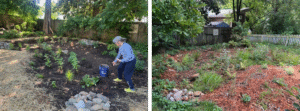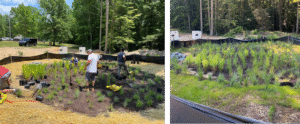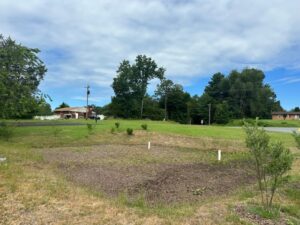Projects
Collaboration for Clean Water
Many of my projects this past year were the products of ongoing partnerships and collaborations. It has been gratifying to see how a collaborative spirit can enhance outcomes and bring various skillsets and personalities together to promote better and more innovative solutions. This past year, several of my collaborative partners have included the National Fish & Wildlife Foundation, the Chesapeake Conservation Landscaping Council, Ecosystem Services, LLC, the South River Watershed Coalition, Appalachian Voices, the Virginia Conservation Assistance Program, Wetlands Watch, and Friends of the Rapphanncok, among others.
The list below summarizes several of my current projects.
Field Liaison for National Fish & Wildlife Foundation (NFWF)
I serve as one of the NFWF field liaisons in the Bay Watershed. Together with NFWF staff in the Chesapeake Bay Stewardship Fund program, the field liaisons work with both current and prospective grantees to assist with project development and implementation. One of the key areas is to help build collaborations and partnerships aimed at achieving Chesapeake Bay clean-up goals.
Please feel free to contact me if you need assistance with developing a project idea, partnership, or resolving issues with an existing project. dave@hirschmanwater.com.

NFWF Site visit to the Elizabeth River Project’s Ryan Reslience Lab, an innovative campus features living shorelines, conservation landscaping, rain gardens, rainwater harvesting, and many green building features.
Chesapeake Conservation Landscaping Council — CBLP Grows & Matures
The Chesapeake Conservation Landscaping Council is the organization that sponsors the Chesapeake Bay Landscape Professional (CBLP) certification program, among other efforts.
I have been honored to work with a host of talented program staff and trainers since the inception of this training and certification program in 2016. I have led the stormwater training sections for numerous Level 1 classes across the Bay Watershed. In the past several years, I have helped instruct various Level 1 classes, the CBLP-Associate program for youth workforce audiences, the CBLP-Crews class for stormwater maintenance crew members, and specialty classes for VDOT, the Virginia Conservation Assistance Program (VCAP), the Pennsyvlania Outdoor Corps, the Pennsylvania Watershed Stewards program, and the Chautauqua Watershed Conservancy.
Collectively, the CBLP offerings are an important component in raising the bar across the Chesapeake Bay Watershed for sustainable landscaping and a more enlightened approach to planting design (including in stormwater practices) and, importantly, a more engaged approach for long-term maintenance and adaptive management.

Chris Sonne demonstrates different methods for conducting an infiltration test at the CBLP training for VCAP in Lynchburg.
Towards More Resilient Communities
The whole practice of stormwater management is pivoting (or pivoting back) to flood preparedness and resilient planning. Of course, we have all witnessed the changing climate and rainfall patterns with profound implications for our stormwater infrastructure and health of our communities.
I have been fortunate to be able to work on these issues at the state-wide and local scales. For Virginia, I have been on a team with Arcadis and other partners to develop an update to the Virginia Flood Protection Master Plan, under the guidance of the Virginia Department of Conservation & Recreation. Many state-level stakeholders have been involved to develop this plan that will guide how state agencies will coordinate and build capacity for flood protection across the Commonwealth.
At the local level, I have been working with the Town of Pennington Gap, VA, Appalachian Voices, and Ecosystem Services, LLC to develop a local flood preparedness plan. This is through a planning and capacity building grant from the Community Flood Preparedness Fund, adminstered by Virginia DCR. This fund has been supporting flood planning and project implementation through five grant cycles.

The team conducted field reconnaissance to identify opportunities for nature-based solutions to flooding. Left: Town Greenway along the North Fork Powell River. Right: Example of repetively-flooded building along the river. Photos: Kip Mumaw, Town of Pennington Gap.
South River Watershed Coalition
The South River Watershed Coalition (SRWC) grew out of a twenty year effort to remediate mercury contamination in the South River, which runs through Waynesboro, VA and north to its confluence with the South Fork Shenandoah. After many years of research, pilots, and streambank remediation work, the former South River Science Team tansitioned into a community-based watershed group that will have a watershed-wide focus. The SRWC Board started meeting in 2023 and is formulating programs and projects.
For the past several years, I worked with others in the community to form the Board and assist with start-up activities. We have also continued the previous work with DV Entertainment to create a series of educational videos about the South River watershed for English and Spanish-speaking audiences.
Here is an example that addresses the story of Mercury contamination and remediation in the South River. Other videos can be viewed at the link above.
Stormwater Design: Small to Large
I have worked with partners on the design and installation of stormwater practices at different scales, from backyard rain gardens installed through the Virginia Conservation Assistance Program to larger stormwater practices, commonly on public land. Here is a summary of some recent efforts.

I worked with Ecosystem Services, LLC, Wolf Josey Landscape Architects, and the City of Waynesboro, VA on the creation of the Loth Springs Natural Area, currently under construction. The project features daylighting of a historic spring, a large constructed stormwater wetland (pictured) to treat a whole neighborhood that previously discharged to the spring and South River, and large naturalized areas with tree planting and native seed mixes. Note that the wetland design features multiple cells, and lenghtened flow path, and use of biochar on the side slopes. Photo: Ecosystem Services, LLC

On a much smaller scale, this is a rain garden, funded through the VCAP program. Left: at time of planting in June ’24. Right: June ’25 after several inches of rain. Photos: D. Hirschman.

I worked with the Friends of the Rapphannock and the Rappannock Tribe to desing and build this bioretention area at the Tribal Center. Left: planting by volunteers in Fall ’23. Right: one year later. The planting design is a lower-maintenance grassland environment. Photos: D. Hirschman & Rappahannock Tribe.

This is another project with the Friends of the Rappahannock — bioretention at the George Washington Carver Agricultural Research Center near Culpeper, VA. The project was planted last fall. Photo: Friends of the Rappahannock.
A Few Other Grant-Funded Projects
- Biochar! I worked with a team, led by the Center for Watershed Protection and including Infinite Solutions, University of Deleware, and the U.S. Biochar Initiative on the Scaling Up Biochar project, aimed at increasing use of biochar for stormwater treatment in the Chesapeake Bay Watershed. The project was funded by the National Fish & Wildlife Foundation, and included several field demos, including the one below.

Stormwater wetland side slopes. Foreground: no biochar was mixed into the topsoil. Beyond: biochar mixed into topsoil. This is just a couple of weeks after planting.
- MD Port Towns Stormwater: This collaboration included the University of MD, Environmental Finance Center, Skeo Solutions, and many representatives from the MD Port Towns along the Anacostia River. The project included walkability with stormwater treatment to develop a wide-ranging plan of action.
- National Science Foundation, iCorps mentor for Morgan State University: I assisted the Morgan State team as it participated in the rigorous iCorps program, intended to guide university programs that have a technology or project to bring to market. My role was the “Industry Mentor,” as the team conducted over 100 interviews with stormwater stakeholders.
- Wetland Watch & CBLP — Beyond the Bay: I am assisting Wetlands Watch and CBLP with extending aspects of the CBLP curriculum and training to the Roanoke and New River watersheds in Southwest VA. We are planning to BMP workshop and tour slated for later this Fall.
